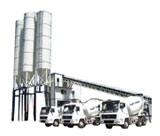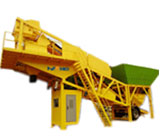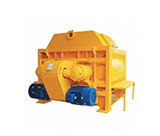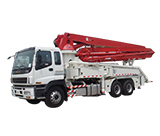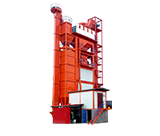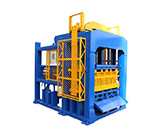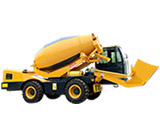Wet Mix Stationary Concrete Batching Plants
2025.10.29
A wet mix stationary concrete batching plant is a concrete production equipment integrating automated production, precise metering, and environmental control. Its core feature is that aggregates, cement, water, and admixtures are wet mixed in a single process within the batching plant, and its fixed installation structure ensures long-term stable operation.Technical principles of wet mix stationary concrete batching plant:
The wet mix process differs from dry mix concrete plants. In a wet mix concrete plant, all water is added directly during the mixing process, allowing aggregates, cement, and other raw materials to be thoroughly mixed within the mixing unit to form a homogeneous concrete mixture. This process effectively controls the water-cement ratio of the concrete (typically 0.35-0.70), ensuring strength and durability.


Production flow of wet mix stationary concrete batching plant:
- Batching stage:
Aggregates are fed into the batching machine via a loader or belt conveyor and independently metered by an electronic scale (accuracy ±1%). Cement, fly ash, and other powdered materials are conveyed from silos to powder metering hoppers via screw conveyors. Water and admixtures are precisely controlled through a liquid metering system.
- Mixing stage:
A twin-shaft concrete mixer (such as the JS1500 model) is used, with a 1-minute automatic cycle time to complete dry mixing (30 seconds) and wet mixing (45 seconds), ensuring material uniformity.
- Unloading and transportation:
The mixed concrete is directly loaded into a dedicated mixer truck through the unloading hopper. The tank rotates continuously at a low speed (2-6 rpm) to prevent segregation. After transportation to the construction site, it is poured using pumping or self-unloading.
Five core systems of wet mix stationary concrete batching plant:
- Mixing system:
The twin-shaft concrete mixer is the mainstream configuration. For example, the HZS150 concrete batching plant is equipped with a 3m³ main mixer, with a theoretical production rate of 150m³/h. The mixing blades are made of high-chromium wear-resistant cast iron, extending their service life by 30%.
- Batching system:
There are usually 3-4 aggregate bins, using cumulative weighing or independent weighing methods. For example, the PLD2400 batching machine in the HZS75 concrete batching plant can process four types of aggregates simultaneously, and the metering hopper is equipped with a high-precision sensor.
- Conveying System:
Aggregates are conveyed via a large-angle belt conveyor (angle ≤ 50°) or a winch-lifted hopper; powder materials are conveyed using Φ273-Φ325 screw conveyors, with a conveying efficiency of 80-150 t/h.
- Control System:
An industrial computer + PLC (such as Siemens S7-1200) enables fully automatic control, supporting functions such as recipe storage, drop correction, and fault diagnosis. The operating interface integrates a touch screen and a remote monitoring module.
Environmental protection system of wet mix stationary concrete batching plant:
- Dust control:
The mixing tower is fully enclosed and equipped with a pulse bag filter (dust removal efficiency ≥ 99.5%). Dust collectors are installed on the top of the silos, and the aggregate conveying pipelines are sealed.
- Wastewater treatment:
A three-stage sedimentation tank (volume ≥ 50 m³) treats vehicle wash water and equipment cleaning water, with a recycling rate of over 90%.
- Noise control:
The main unit and motors are equipped with soundproof enclosures, and the control room is isolated from the production area. Plant boundary noise is ≤60dB(A).
A typical configuration is taken as an example of the HZS75 concrete batching plant, which includes a JS1500 mixer, a PLD2400 batching machine, and four 100t cement silos, with a theoretical capacity of 75m³/h and a floor area of approximately 2000㎡. It is suitable for small and medium-sized infrastructure projects. The HZS120 concrete batching plant adopts a dual-main-unit design and is equipped with an intelligent control system to meet the high-standard concrete production requirements of high-speed railway box girders, etc.
Application advantages of wet mix stationary concrete batching plant:
1. Quality control advantages
- Precise metering:
A fully electronic independent weighing system (aggregate, powder, and liquid are metered separately) ensures that the mix proportion error is ≤±1%, especially suitable for the production of high-strength concrete above C50.
- Uniformity guarantee:
Forced mixing ensures that the standard deviation of the slump of the concrete mixture is ≤10mm, the bleeding rate is ≤1.5%, and the strength dispersion is significantly reduced.
2. Environmental protection and cost effectiveness
- Environmentally friendly:
Compared to dry mix concrete plants, wet-mixing processes eliminate the need for aggregate drying, reducing coal or natural gas consumption and lowering dust emissions by over 60%.
- Cost Savings:
Equipment investment is 75% lower than dry mix concrete batching plants, primarily due to the no-drying process and lower transportation costs.
- Resource recycling:
All sludge from sedimentation tanks and dust collected by dust collectors are recycled for production, achieving zero solid waste emissions.
3. Automation and Management Efficiency
- Intelligent Production:
Real-time monitoring of equipment operation status, raw material consumption, and vehicle scheduling via IoT technology increases production efficiency by 30%.
- Data Traceability:
The system automatically records the production time, mix proportions, and raw material sources for each batch of concrete, supporting quality traceability and construction management optimization.
Selection Recommendations
- Capacity matching:
Select different models from HZS35 (35m³/h) to HZS240 (240m³/h) based on project requirements. For small and medium-sized projects, HZS75-HZS120 are the mainstream.
- Level of intelligence:
Prioritize equipment equipped with IoT monitoring and automatic sand and gravel moisture content compensation.
- Localized service:
24-hour after-sales response, ample spare parts inventory, reducing maintenance costs.
Wet mix stationary concrete batching plants, with their high efficiency, environmental friendliness, and intelligence, have become the mainstream choice for infrastructure and commercial concrete industries. Through precise process control, localized equipment configuration, and strict environmental management, these concrete batching plants can not only meet the production needs of different grades of concrete, such as C30-C50, but also effectively reduce energy consumption and emissions, contributing to the green and intelligent advancement of construction.

